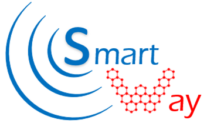Description of Work Packages
SMARTWAY workplan is built in 3 phases and corresponding technical work packages. A fourth management work package pilots the project’s deployment and manages the exploitation of the project results.
The organizational structure is shown in Figure below

WP1
aims at the design and development of the elementary technological bricks of the system. These 4 technological bricks are subsystems that will benefit from the project to increase their TRLs (MM antenna, CNT NEMs- based switch and filter, mm-wave radar chipsets, and the heterogeneous integration of the system). At the end of WP1, the goal is to bring all the baseline technologies with a TRL of higher than 6.
WP2
aims at developing the system modules and their integration in larger subsystems. The main objective of this phase is to develop the MRL levels of the technological bricks envisaged in WP1. A key step is the optimization of the CNT NEMs-based switch and filter to match it to the 60GHz radar chipset by means of impedance matching. Secondly, a MM-based antenna will be optimized for the 300GHz radar chipset by means of miniaturization and suppression of the substrate waves by help of the MM structures. Lastly, the heterogeneous integration processes of the systems will also be developed under this WP. Moreover, the WP2 aims at the integration of the WP1 modules into a system providing thermal and electrical interconnects for the different devices. MRL levels of all the fabrication and processing methods will be verified under WP2 to ensure that the entire production line with its sub-production steps passes the MRL of 6.
WP3
covers the validation and demonstration tasks. Two demonstrators of the SMARTWAY project will be realized under WP3. The system level integration (digital controls, FPGA etc.) will be designed for integration of the WP2 subsystems in a single product for each demonstrator. In parallel the full radar product characterization setup for the system will be developed. A first validation at the relevant environment will allow the test of each subsystem with respect to their role. The validation of both DEMO#1 and DEMO#2 will be done in a relevant environment. The final task of the WP3 is the demonstration of both demo systems, in an environment relevant for its final use (TRL6).
WP4
focuses on project work-flow management, Intellectual Property to ensure that the technology is properly safeguarded, and marketing strategy to promote commercialization. An additional subtask of WP4 is the prospect and selection of potential market penetration during the project to ensure maximum impact at the demo system level.

The Smartway project is funded by HORIZON-EIC-2022-TRANSITION-01 under the grant agreement 101103057
